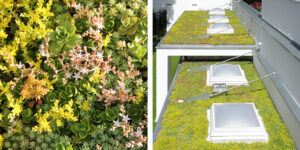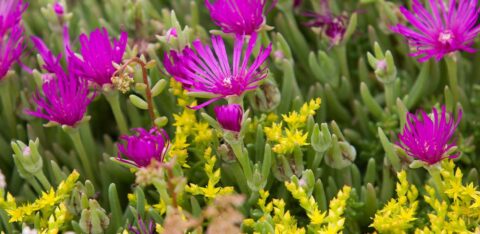Everything about sedum
23 November 2021Green roofs are increasingly applied on flat roofs. There are intensive and extensive green roofs. Within extensive green roofs, there are also different types and sizes. An example of an extensive green roof is a sedum roof. This is a roof fully planted with Sedum. A sedum roof offers many benefits, but what is sedum actually? Read further what sedum is and how this can be implemented easily on a roof
What is sedum?
Sedum is a plant that comes from the Crassulaceae family. There are 400 to 500 different types of sedum. Sedum plants, also known as succulents, are plants that absorb water and store it in their leaves. Since Sedum stores water in the leaves, Sedum is a drought-tolerant plant that can withstand dry weather. This makes it a plant species that makes few demands on the location, which means that it grows well in almost every weather condition. Not only is Sedum a popular product for this reason, but the combination of its beautiful appearance also makes it ideal for use on the roof.

Lightweight and easy to maintain
Sedum was previously known as a ground cover. It is mainly used to cover a large area of soil. Due to the increasing popularity of green roofs, sedum is, therefore, more and more used on roofs. The characteristics of this succulent also make it an ideal plant species to be used for green roofs. Sedum is light in weight. This is important because, when a green roof is installed, the construction underneath must be able to support the weight of a green roof. The leaves of the sedum plants change colour during the year which ensures that every season, a green roof has a different colour. In the fall, a reddish-brown green roof can develop while a green-looking roof can be enjoyed in the spring. Succulents are also very easy to maintain. This makes the maintenance of a green sedum roof very easy.
Biodiversity and air purification
Sedum also contributes to biodiversity. The plants and flowers attract insects such as butterflies, honeybees and bumblebees. These insects contribute to cross-pollination and therefore stimulate biodiversity. A roof planted with Sedum also offers food and nesting places to for example birds. One can also help extra by placing a beehive or birdhouse on the green roof. By applying sedum roofs, a contribution to biodiversity can still be made in urban areas with little greenery. Sedum plants are also capable of capturing particulate matter. Particulate matter are dust particles in the air that have harmful effects on health. The succulents also absorb CO2, one of the biggest causes of climate change. Thus, it also improves air quality.
Sedum therefore has many benefits and these benefits can easily be enjoyed with a sedum roof. Interested in a sedum roof? Have a look at the MobiRoof ECO green roof system from Mobilane.



